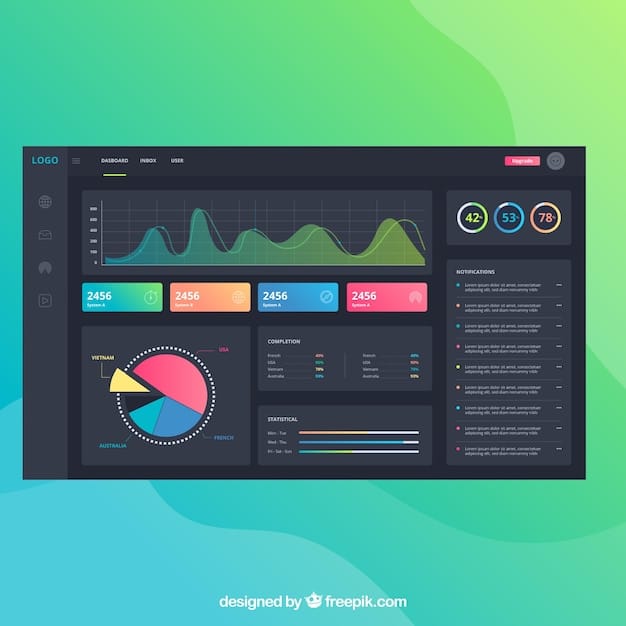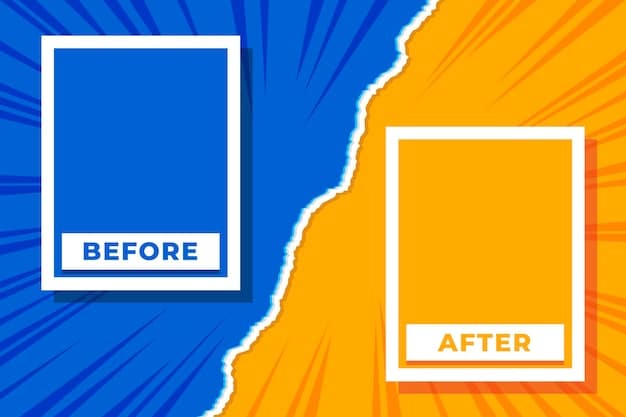Adapting SEO: Core Web Vitals Update (2025)

Navigating the ever-evolving landscape of SEO requires a continuous understanding of Google’s algorithm shifts, and the 2025 Core Web Vitals update emphasizes the critical role of user experience, demanding proactive adaptation of current strategies to maintain and improve search rankings and online visibility.
The digital marketing world is constantly shifting, with Google’s algorithmic updates frequently redefining the rules of engagement. Staying ahead means not just reacting, but proactively adapting your SEO strategy. Understanding how to adapt your SEO strategy to Google’s Core Web Vitals Update (2025) is no longer an option, but a necessity for digital success.
Understanding the Evolution of Core Web Vitals
Google’s commitment to user experience has been unwavering, and the Core Web Vitals (CWVs) serve as fundamental metrics for evaluating how users perceive the performance of web pages. Initially introduced as a significant ranking factor in 2021, these metrics have undergone continuous refinement and evolution, with the 2025 update signifying a more mature and integrated approach to how page experience impacts search rankings.
The core concept remains consistent: prioritize speed, responsiveness, and visual stability. However, the exact weighting and new considerations within the 2025 framework will likely offer more nuanced interpretations of user interaction. It’s not just about hitting green scores; it’s about understanding the qualitative impact these metrics have on actual user behavior and engagement.
Deep Dive into the Core Metrics
The three original Core Web Vitals still form the bedrock of Google’s page experience assessment, though their measurement methodologies and real-world implications continue to evolve. Understanding each is crucial for effective optimization:
- Largest Contentful Paint (LCP): This measures loading performance, specifically the time it takes for the largest content element on the page to become visible. A slow LCP means users are left waiting, potentially leading to immediate abandonment.
- First Input Delay (FID): Now often replaced by INP (Interaction to Next Paint) as the primary responsiveness metric, this originally measured the time from when a user first interacts with a page (e.g., clicking a button) to the time when the browser is actually able to begin processing that interaction. A high FID indicates a sluggish, unresponsive page.
- Cumulative Layout Shift (CLS): This quantifies visual stability, measuring the sum of all unexpected layout shifts that occur during the lifespan of a page. Unstable layouts are jarring and frustrating for users, especially when they attempt to click on something that suddenly moves.
The 2025 update brings an increased emphasis on Interaction to Next Paint (INP), which provides a more comprehensive measure of responsiveness throughout the entire page lifecycle. This shift underscores Google’s desire to capture the full spectrum of user interaction and not just the initial load or first click. Optimizing for INP involves identifying and resolving long-running tasks, minimizing main-thread blocking, and ensuring smooth, predictable interactions.
Moreover, while the core three remain key, anticipate Google to likely integrate other signals that contribute to a holistic user experience. Factors such as mobile-friendliness, safe-browsing, HTTPS security, and intrusive interstitial guidelines will continue to play a role alongside the CWVs, further solidifying the importance of a comprehensive approach to site health.
In essence, the evolution of Core Web Vitals is a clear signal that SEO is increasingly intertwined with UX. A highly optimized technical foundation now goes hand in hand with a delightful user journey, driving both rankings and conversions.
Key Changes and Anticipated Impacts of the 2025 Update
The 2025 Core Web Vitals update is poised to further solidify user experience as a paramount ranking signal within Google’s algorithm. While Google rarely pre-announces every specific detail of algorithm changes far in advance, historical patterns and public statements provide strong indicators of the direction they are headed. The emphasis on real-world user data, the shift towards more continuous measurement, and the potential integration of new or refined metrics are all factors that SEO professionals must consider.
One of the most significant changes is the widespread adoption of Interaction to Next Paint (INP) as a primary responsiveness metric, replacing FID in many contexts. INP is a more robust indicator of overall page responsiveness, as it tracks the latency of all interactions a user makes with a page, not just the first one. This demands a deeper dive into JavaScript execution, rendering processes, and potential bottlenecks throughout a user’s session.
Furthermore, expect the 2025 update to place a greater emphasis on the consistency of CWV performance across a site. It won’t be enough for just a few key pages to perform well; Google aims for a uniformly excellent user experience across an entire domain. This consistency factor will likely reward sites that have a robust, scalable approach to performance optimization, rather than those that only fix issues on an ad-hoc basis.
Impact on Search Rankings and Visibility
Sites that consistently deliver excellent Core Web Vitals will likely see improved organic search visibility, especially for competitive keywords. Conversely, those that neglect these metrics may experience stagnation or even declines in their rankings, regardless of the quality of their content or backlink profile. It’s a holistic assessment, and poor performance in user experience can now effectively negate efforts in other SEO areas.
Beyond direct ranking impacts, improved CWVs contribute to higher engagement metrics like lower bounce rates and increased time on page. These improved user signals can, in turn, indirectly boost rankings and provide a better return on investment for traffic acquisition. The tighter integration of CWVs with overall page experience signals means that Google is looking for sites that are truly useful and enjoyable for users, not just those that are technically sound.

Adapting Your Content Strategy
The 2025 update compels content creators and marketers to think beyond keywords and subject matter. The way content is delivered—its technical performance—is now as crucial as the content itself. This doesn’t mean sacrificing quality for speed, but rather ensuring that quality content is presented in an optimally performant manner.
Publishers might need to reconsider overly complex page layouts, excessive third-party scripts, or very large image files that hinder loading times and responsiveness. The shift towards INP suggests that highly interactive content will need to be meticulously optimized to ensure smooth user interactions. This could lead to a preference for more streamlined, efficient web design practices that prioritize the user journey over purely aesthetic considerations.
In essence, the 2025 Core Web Vitals update reinforces the idea that SEO is no longer just about optimizing for robots, but fundamentally about optimizing for human beings. Sites that embrace this philosophy will be well-positioned for long-term success in Google’s search results.
Essential Tools and Metrics for Measurement
Accurate measurement is the cornerstone of effective Core Web Vitals optimization. Without reliable data, identifying issues and tracking progress becomes a guessing game. Fortunately, Google provides a robust suite of tools that offer both lab data (simulated environments) and field data (real-user experiences), each serving a unique purpose in the optimization process.
Google Search Console (GSC)
Google Search Console is indispensable for monitoring your site’s CWV performance based on real user data. The “Core Web Vitals” report within GSC provides a summary of your pages’ performance (categorized as Good, Needs Improvement, or Poor) for both mobile and desktop. This field data is collected from the Chrome User Experience Report (CrUX), reflecting how actual users interact with your site.
The beauty of GSC’s report lies in its focus on URLs rather than individual metrics, allowing you to identify specific page groups that require attention. It also highlights the predominant issues affecting those pages, guiding your optimization efforts towards high-impact areas. Regularly checking this report is a fundamental practice for any SEO professional.
PageSpeed Insights (PSI)
PageSpeed Insights offers a comprehensive analysis of a specific URL, providing both lab data (from Lighthouse) and field data (from CrUX) for Core Web Vitals and other performance metrics. Lab data is crucial for debugging and identifying specific technical issues, as it allows for consistent, reproducible testing.
- Lab Data: PSI’s Lighthouse audit simulates a page load under consistent conditions, offering a diagnostic report that pinpoints performance bottlenecks, such as excessive JavaScript execution, large image files, or render-blocking resources.
- Field Data: The CrUX data presented in PSI gives you a real-world perspective on how users experience your page, including percentile scores for LCP, INP, and CLS. This helps confirm whether your optimizations are translating into tangible improvements for actual visitors.
PSI also provides actionable recommendations categorized by impact, making it easier to prioritize fixes. It’s a powerful tool for deep-diving into individual page performance and getting a clear picture of what needs to be done.

Chrome DevTools
For developers and SEOs who want to perform granular, real-time testing, Chrome DevTools offers a wealth of features within the browser itself. The Lighthouse panel, Performance panel, and Coverage panel are particularly useful for Core Web Vitals optimization.
- Lighthouse Panel: Runs a Lighthouse audit directly from your browser, providing a quick way to check CWV scores and get immediate suggestions for improvement on the fly.
- Performance Panel: Allows for detailed recording of page load and interaction, visualizing the Main Thread activity, network requests, and rendering processes. This is invaluable for identifying long tasks, layout shifts, and input delays.
- Coverage Panel: Helps identify unused CSS and JavaScript, which can be significant contributors to slow loading times and script blocking. Removing or deferring these unused resources can dramatically improve LCP and INP.
While lab tools like DevTools are excellent for diagnosis, always cross-reference your findings with field data from GSC and PSI. Real user data is the ultimate arbiter of your CWV performance, and lab simulations, while helpful, may not always perfectly replicate the vast array of real-world user devices, network conditions, and interactions.
By leveraging these tools effectively, SEO professionals can pinpoint performance bottlenecks, implement targeted optimizations, and continuously monitor their site’s Core Web Vitals against Google’s evolving expectations for 2025 and beyond.
Practical Strategies for Optimizing Core Web Vitals
Optimizing for Core Web Vitals requires a technical yet practical approach. It involves a combination of front-end web development best practices, server-side configurations, and strategic content delivery. The goal is to create a seamless experience from the moment a user requests a page until they fully interact with it without frustration.
Improving Largest Contentful Paint (LCP)
LCP is all about delivering the main content quickly. Strategies typically revolve around minimizing the size and time it takes to load the largest element on the page, whether it’s an image, video, or block of text.
- Optimize Images: Use modern image formats like WebP or AVIF, compress images, and implement lazy loading for images below the fold. Ensure images are appropriately sized for their display context.
- Minimize Render-Blocking Resources: Defer or asynchronously load CSS and JavaScript that aren’t critical for the initial render of the page. Use critical CSS to inline styles needed for the above-the-fold content.
- Server Response Times: Improve your server’s response time by using a fast hosting provider, implementing a Content Delivery Network (CDN), and optimizing your server-side code and database queries.
- Font Optimization: Ensure custom fonts load efficiently. Use
font-display: swapto render text in a fallback font until the custom font is loaded, preventing invisible text during load.
These actions significantly impact how quickly the most important content on your page becomes visible and usable to the visitor, directly influencing their initial impression.
Enhancing Interaction to Next Paint (INP)
As the primary responsiveness metric for 2025, optimizing INP requires a focus on making your page respond quickly to all user inputs. This goes beyond initial load and encompasses the entire user journey on your page.
- Reduce JavaScript Execution Time: Large JavaScript bundles can block the main thread, delaying interactions. Minify, compress, and split your JavaScript into smaller chunks that can be loaded on demand.
- Optimize Third-Party Scripts: External scripts (ads, analytics, social widgets) can severely impact INP. Evaluate their necessity, load them asynchronously, or defer their loading until after critical content has been interactive.
- Avoid Long Tasks: Break up long-running JavaScript tasks into smaller, asynchronous operations. This prevents the main thread from being blocked, ensuring that user interactions can be processed swiftly.
- Debounce and Throttle Input Handlers: For events that fire frequently (like scrolling or typing), debouncing or throttling can limit the number of times the event handler is executed, preventing performance bottlenecks.
A performant INP often points to a well-architected and efficient front-end, where resources are managed intelligently to prioritize user responsiveness.
Mitigating Cumulative Layout Shift (CLS)
CLS aims to measure visual stability. Unexpected layout shifts are frustrating and can lead to misclicks, so preventing them is crucial for a smooth user experience.
- Specify Dimensions for Images and Videos: Always include
widthandheightattributes for images and video elements. This allows browsers to reserve the necessary space before the media actually loads, preventing content shifts. - Reserve Space for Ads and Embeds: Dynamically injected content from ads or third-party embeds can cause significant shifts. Pre-allocate adequate space for these elements using CSS, even if their exact dimensions aren’t initially known.
- Avoid Inserting Content Above Existing Content: Unless in response to a user interaction, avoid dynamically adding content (like banners or pop-ups) above content that has already loaded.
- Animate Transforms, Not Properties that Trigger Layout: Use CSS transform properties (like
transform: scale()ortransform: translate()) for animations, as these do not trigger layout recalculations. Avoid animating properties likewidth,height, orleft, which can cause shifts.
By addressing these common causes of layout shifts, you can create a more predictable and enjoyable visual experience for your users, improving your CLS score and overall page stability.
Leveraging Technical SEO Beyond Core Web Vitals
While Core Web Vitals are foundational for page experience, a comprehensive technical SEO strategy extends far beyond these three (or four, including INP) metrics. A technically sound website is one that Google can easily crawl, index, and understand, forming the bedrock upon which all other SEO efforts are built.
Crawlability and Indexability Optimization
Ensuring Google can effectively crawl and index your site is paramount. This involves:
- XML Sitemaps: Maintain an accurate and up-to-date XML sitemap, submitting it to Google Search Console. This helps search engines discover all important pages on your site.
- Robots.txt: Use your robots.txt file to guide search engine crawlers, blocking access to non-essential pages (e.g., admin pages, duplicate content) while allowing access to important content.
- Canonicalization: Implement canonical tags to prevent duplicate content issues, guiding search engines to the preferred version of a page.
- Noindex/Nofollow Directives: Strategically use
noindexmeta tags for pages you don’t want in search results andnofollowfor links you don’t want to pass link equity.
Poor crawlability or indexability can severely limit your site’s visibility, regardless of how good its Core Web Vitals are. It’s a foundational technical requirement.
Structured Data Implementation
Structured data, also known as schema markup, helps search engines better understand the content on your pages. By adding specific code snippets, you can provide context about your content, which can lead to rich snippets (e.g., stars for reviews, dates for events) in search results. This can significantly improve click-through rates (CTRs) even if your organic ranking remains constant.
Common types of schema markup include:
- Product schema for e-commerce sites
- Review schema for aggregating user reviews
- Article schema for blog posts and news articles
- FAQ schema for frequently asked questions
- Local Business schema for physical locations
Implementing structured data isn’t a direct ranking factor, but its impact on visibility and CTR makes it an undeniable component of modern technical SEO. Use Google’s Structured Data Testing Tool and Rich Results Test to validate your implementation.
Mobile-First Indexing and Responsiveness
Google’s mobile-first indexing means they primarily use the mobile version of your site for indexing and ranking. Therefore, a truly responsive design that adapts seamlessly across all devices (desktops, tablets, smartphones) is non-negotiable.
Key considerations include:
- Viewport Meta Tag: Ensure your pages include the
<meta name="viewport" content="width=device-width, initial-scale=1.0">tag to correctly scale content to the device. - Touch-Friendly Elements: Buttons and clickable elements should be adequately sized and spaced for easy tapping on touch devices.
- Fast Mobile Page Load: Beyond CWVs, general mobile page speed is critical. Avoid large assets, excessive third-party scripts, and slow server responses on mobile.
- Content Parity: Ensure that the content, including text, images, and structured data, is consistent between your mobile and desktop versions.
A site that provides an excellent experience across all device types will not only be favored by Google but will also retain users, leading to better engagement metrics and ultimately, higher conversions. Technical SEO is an ongoing process that requires continuous monitoring and adaptation to Google’s evolving guidelines and technological advancements.
Holistic SEO: Integrating CWVs with Content & Link Building
While technical optimization for Core Web Vitals is crucial, it’s essential to remember that it’s just one pillar of a successful SEO strategy. For true long-term success, CWV efforts must be seamlessly integrated with robust content and link-building initiatives. Google’s algorithms are designed to reward truly valuable resources, and the technical foundation simply ensures that value can be easily discovered, accessed, and appreciated by users.
Content Quality and Relevance
Even the fastest, most performant website will struggle to rank if its content is subpar. High-quality, relevant, and authoritative content remains the king of SEO. When users land on a page, they expect to find answers to their questions, solutions to their problems, or engaging information.
- User Intent: Understand the intent behind search queries and create content that directly addresses that intent. This means going beyond keyword stuffing to truly satisfy what a user is looking for.
- Depth and Comprehensiveness: Provide thorough, well-researched, and unique perspectives. Long-form content, when well-written and structured, often performs well because it covers topics extensively.
- Engagement Factors: Structure your content for readability with headings, bullet points, and short paragraphs. Incorporate multimedia (images, videos, infographics) to break up text and enhance engagement. Tools like Grammarly and Hemingway app can help improve readability.
- E-E-A-T Principles: Demonstrate Experience, Expertise, Authoritativeness, and Trustworthiness. This involves showcasing credentials, citing sources, and building a reputation as a reliable source of information.
A fast-loading page with poor content will lead to high bounce rates and low time on page, signaling to Google that the user was not satisfied, overriding any CWV benefits.
Strategic Link Building
Backlinks from authoritative and relevant websites continue to be a powerful signal of trust and authority to Google. A strong backlink profile can significantly boost your site’s domain authority and search rankings. However, the focus should always be on quality over quantity.
- Natural Link Acquisition: Focus on creating exceptional content that naturally attracts backlinks because other sites want to reference it. This is sometimes called “link earning.”
- Guest Posting: Contribute valuable articles to other reputable sites in your niche, including a contextual link back to your site. Ensure the content is unique and relevant to the host site’s audience.
- Broken Link Building: Find broken links on high-authority websites, create superior content for the broken resource, and then suggest your content as a replacement.
- Competitor Analysis: Analyze the backlink profiles of your top-ranking competitors to identify potential link opportunities and strategies.
A strong backlink profile, combined with technical excellence and compelling content, creates a powerful feedback loop: good content earns links, links boost authority, which helps content rank, and strong Core Web Vitals ensure users stay on the page once they arrive, reinforcing positive signals to search engines.
User Experience as the Unifying Factor
Ultimately, Core Web Vitals, content quality, and link building all converge on a single, overarching goal: providing an excellent user experience. CWVs ensure the technical delivery is smooth, compelling content keeps users engaged, and strong links establish trust and authority.
When these elements work in harmony, they create a virtuous cycle. A technically performant, content-rich, and authoritative site will attract and retain users, leading to better rankings, increased organic traffic, and ultimately, greater digital success. Ignoring any one of these pillars will compromise the overall effectiveness of your SEO efforts in the dynamic landscape of 2025.
Preparing Your Team for Continuous Core Web Vitals Optimization
Adapting to the Core Web Vitals update in 2025 isn’t a one-time project; it’s an ongoing commitment that requires a cultural shift and collaborative effort across various teams within an organization. SEO is no longer confined to a single department; it impacts (and is impacted by) design, development, content, and marketing. Building a resilient strategy involves fostering cross-functional understanding, implementing clear processes, and staying agile in the face of continuous algorithmic evolution.
Cross-Functional Collaboration is Key
Effective CWV optimization demands close cooperation between traditionally siloed teams:
- SEO Team: Responsible for monitoring performance in Google Search Console, identifying critical issues, and translating Google’s guidelines into actionable recommendations.
- Development Team: Crucial for implementing technical fixes, optimizing code, managing server performance, and ensuring that new features are built with performance in mind.
- Design Team: Plays a significant role in preventing CLS by ensuring proper image placeholders, responsible use of animations, and avoiding layouts that cause shifts.
- Content Team: Needs to understand how media choices, embedded elements, and markup impact loading and responsiveness.
Regular communication channels, shared dashboards, and joint training sessions are vital. Performance should be a shared metric that all teams contribute to.
Establishing a Performance Culture
To truly embed CWV optimization, organizations need to foster a “performance culture” where speed and user experience are considered from the very beginning of any project, not as an afterthought. This involves:
- Performance Budgets: Setting strict limits on page weight, JavaScript execution time, or number of requests for new features or pages.
- Automated Testing: Integrating CWV testing into Continuous Integration/Continuous Deployment (CI/CD) pipelines. This ensures that performance regressions are caught early in the development cycle, before they reach production.
- Regular Audits: Scheduling regular, comprehensive Core Web Vitals audits using tools like LightHouse CI or custom performance monitoring solutions.
- Knowledge Sharing: Encouraging developers, designers, and content creators to stay updated on the latest web performance best practices and Google’s recommendations.
A strong performance culture means that every team member understands their role in contributing to a fast, stable, and responsive website.
Staying Agile and Adaptable
The digital landscape is dynamic, and Google’s algorithms continue to evolve. Therefore, an SEO strategy for Core Web Vitals must be agile and adaptable. This means:
- Continuous Monitoring: Don’t just fix issues and forget about them. CWV scores can fluctuate depending on changes to your site, user behavior, or even Google’s measurement methodologies. Implement robust monitoring systems.
- Experimentation: Not every optimization strategy works universally. Be prepared to experiment with different approaches, measure their impact, and iterate based on data.
- Staying Informed: Regularly follow official Google Webmaster Central Blog, Web.dev, and reputable SEO news sources for announcements and best practices related to Core Web Vitals and broader page experience signals. Participate in professional communities to share insights and learn from others’ experiences.
By prioritizing continuous learning, cross-functional collaboration, and an agile mindset, your team can not only adapt to the 2025 Core Web Vitals update but also build a sustainable framework for long-term SEO success in an ever-changing digital environment.
| Key Point | Brief Description |
|---|---|
| 🚀 Evolving CWVs | Google’s 2025 update enhances focus on user experience, with INP replacing FID as a key responsiveness metric. |
| 🔧 Essential Tools | Utilize Google Search Console, PageSpeed Insights, and Chrome DevTools for accurate performance measurement. |
| 💡 Core Strategies | Optimize LCP, INP, and CLS through image compression, JavaScript reduction, and layout stability. |
| 🤝 Team Collaboration | Foster cross-functional efforts and a performance culture for continuous optimization. |
Frequently Asked Questions
▼
In 2025, Google will continue to prioritize Largest Contentful Paint (LCP) for loading performance, Interaction to Next Paint (INP) for responsiveness, and Cumulative Layout Shift (CLS) for visual stability. INP is becoming the definitive metric for responsiveness, moving beyond the initial First Input Delay (FID), capturing a more complete picture of user interaction latency throughout the page’s lifecycle.
▼
Core Web Vitals are a direct ranking factor within Google’s page experience signals. Sites with good CWV scores are more likely to perform better in search results, especially in competitive niches. While content relevance and backlinks remain crucial, poor CWV can hinder visibility. Essentially, a technically sound, fast, and stable website provides a better user experience, which Google rewards with improved rankings.
▼
Google provides several excellent tools: Google Search Console (GSC) offers field data from real users, showing overall site performance. PageSpeed Insights (PSI) gives both lab data (simulated) and field data for specific URLs, along with actionable recommendations. Chrome DevTools allows for in-depth lab testing and debugging within your browser, providing granular performance insights.
▼
While some issues require in-depth development, many common CWV problems have relatively quick fixes. Optimizing images (compressing, using modern formats, lazy loading), specifying image dimensions to prevent CLS, and minifying/deferring non-critical JavaScript and CSS can yield significant improvements. Implementing a Content Delivery Network (CDN) can also dramatically reduce LCP by serving assets faster globally.
▼
Preparing involves fostering cross-functional collaboration between SEO, development, design, and content teams. Establish a “performance culture” by setting performance budgets, integrating automated testing in development pipelines, and conducting regular audits. Crucially, encourage continuous learning and adaptability, as Google’s algorithms are always evolving. Consistent communication and shared responsibility are key to long-term success.
Conclusion
The journey to mastering SEO in 2025, particularly in light of Google’s evolved Core Web Vitals update, underscores a clear truth: user experience is inextricably linked to search engine success. Far from being a mere technicality, CWVs represent Google’s ongoing commitment to deliver the most valuable and enjoyable web experiences to its users. By embracing the nuances of LCP, INP, and CLS, leveraging the right measurement tools, and implementing a holistic strategy that fuses technical optimization with high-quality content and strategic link building, businesses can not only adapt but thrive. Continuous monitoring, cross-functional collaboration, and a proactive mindset will be the hallmarks of successful digital presence, ensuring that your website remains a valuable asset for both Google and, more importantly, your audience.





